- New Products
- Exclusive Gear
- Bushcraft Gear
- Containers
- Cooking
- Fire
- First Aid
- Food Gathering
- Knives & Tools
- Knife Collectors Corner
- Light
- Logo Gear
- Misc. Items
- Navigation
- Packs, Pouches & Bags
- Personal Care
- Repair Gear
- Shelter & Protection
- Signaling
- Urban Survival
- Water
- Writing Gear
- John's Books
- Bargain Bin
Emergency Communications
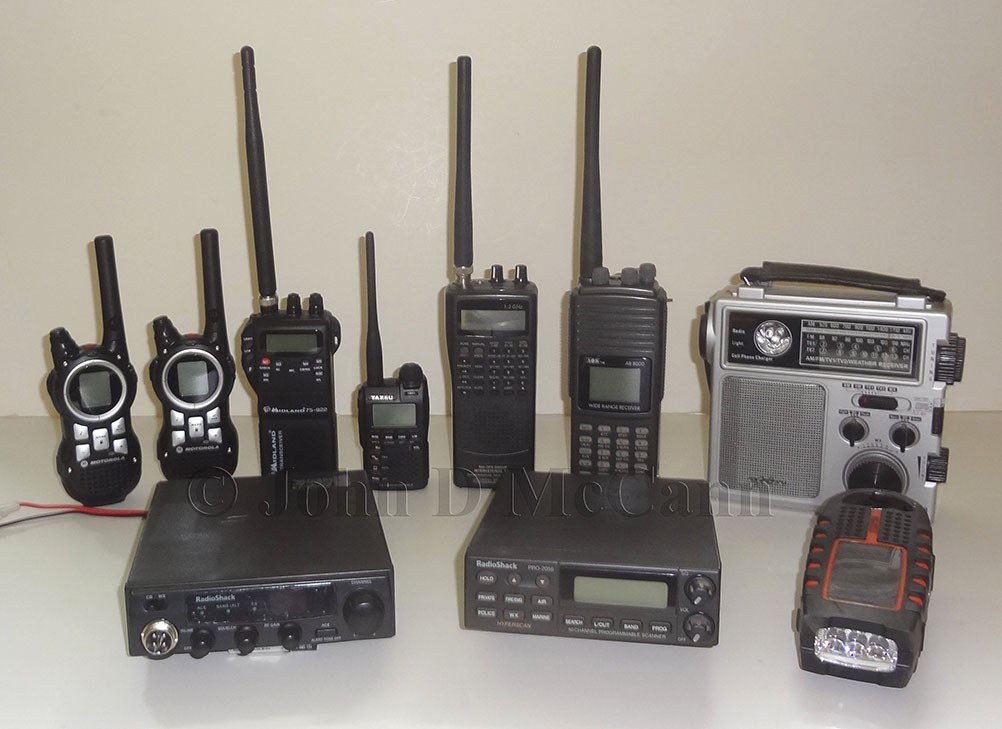
First, I am by no means an expert in communications or electronics, but have been puttering around it for a few years. This article is not intended to be a technical thesis on radio usage or signal propagation. With that being said, it is more a familiarization of the various communication options available for an emergency situation and some basic information about those options.
I have divided the various types of communication devices into One-Way Communications and Two-Way Communications. One-Way Communication devices are called "Receivers" because they only receive radio signals. You can collect information on a receiver, but you cannot communicate with the person providing that information. Two-Way Communication devices are called "Transceivers" because they can both receive and transmit radio signals. They allow you to actually communicate with the person sending information from the other end. Both types of devices can help keep you informed during an emergency situation.
But first, a quick lesson on radio propagation, or the ability for a radio to receive a signal. This obviously is a very simplified description but explains why some radios can talk around the world, and most can't.
Radios that use low frequencies, such as short wave, and some amateur frequencies, can use "Skywave" propagation, also called "Skip," to receive a signal from a radio that is not in a direct line with another radio. The signals can be reflected or refracted from the ionosphere back toward earth. This allows communication around the earth.
However, radios that use frequencies above 300 MHz must use "Direct" propagation, also known as "Line-of-Sight." This means that the antenna of one radio must be able to see the antenna on the radio it wants to communicate with. With small handheld radios and short antennas, this can severely reduce the distance it can communicate, not to mention buildings or hills between the two radios also reduce its capability.
One way to increase the ability for one radio to "see" the other is to raise an antenna up higher. I'm sure you have seen antennas on various buildings as well as cellular towers all over the area. Another way to increase the effective distance a radio can communicate is by using a repeater. The radio you are using actually transmits to a repeater which is usually placed in an elevated position. The repeater then retransmits your signal to the radio you are communicating with. As an example, if a repeater is on a large building, you could be one side and the radio you are communicating with on the other. You would be transmitting up to the repeater and the repeater would transmit your signal back down to the other side. A repeater can definitely increase the effective range you can communicate, but is not very portable and usually not available for normal private radio use.
Therefore, if you are having a problem communicating with another radio, the distance might be more than the effective range of your radio, or "Line-of-Sight" has not been maintained.
ONE-WAY COMMUNICATIONS
AM AND FM RADIOS
Most people have a portable AM/FM radio which will allow you to listen to local broadcast stations which might provide you with information in regard to the current situation. There are various types of radios that offer these bands, and many of them have the ability to be recharged using a hand crank built into the radio, and some even have a small built-in solar panel that allows to you recharge the radio using the power of the sun. These are handy attributes to look for in an emergency radio.
I am often asked what the difference is between AM and FM. Without getting too technical, these are the major differences. AM (Amplitude Modulation) transmits between 535 KHz and 1705 KHz. It has poorer sound quality than FM, is cheaper, and can transmit over longer distances. Having a lower bandwidth, it can have more stations in a frequency range. FM (Frequency Modulation) transmits between 88 MHz and 108 MHz. FM is not affected by interference as much as AM, but FM signals are negatively affected more by physical barriers. FM does have better sound quality than AM due to its higher bandwidth.
WEATHER BAND RADIOS
The addition of a Weather Band Radio, which often includes AM and FM, will allow you to receive information and warnings in regard to the current weather situation, as well as other hazards. Weather Band Radios actually receive broadcasts known as NOAA Weather Radio - (NWR), also known as NOAA Weather Radio All Hazards. The NWR is a service of the National Oceanic and Atmospheric Administration (NOAA), and is a nationwide network of radio stations in the United States transmitting continuous weather information directly from the nearest National Weather Service (NWS) office. The NWS broadcasts official weather service warnings, watches, forecasts, and other hazard information 24 hours a day, 7 days a week. They also may broadcast non-weather related emergency information, such as in the event of a natural disaster, an AMBER alert, or a terrorist attack. As you can see, this information could be very useful in an emergency situation.
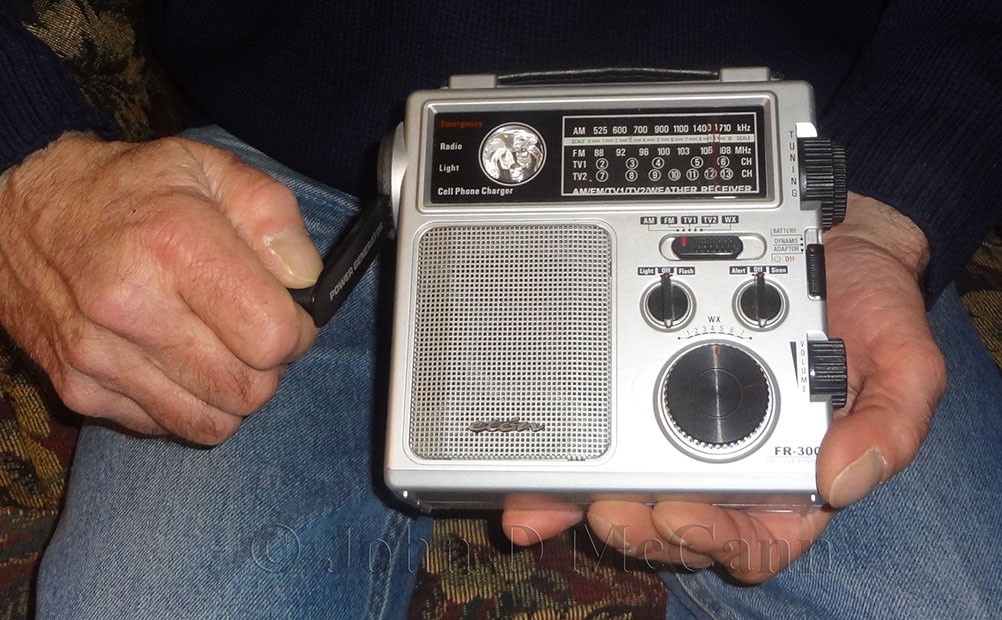 This shows the author charging his ETON Emergency portable radio using the hand crank. It receives
This shows the author charging his ETON Emergency portable radio using the hand crank. It receives
AM, FM, TV1, TV2, and Weather Band. It is battery powered but can be charged with the hand crank.
It can also be used to charge a cell phone and has an LED light. This a handy radio to have when the
power goes out
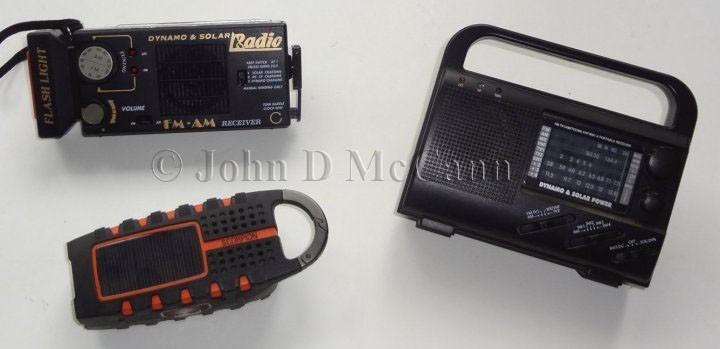 This shows some of the other radios the author has. The radios at the top and bottom left both have hand
This shows some of the other radios the author has. The radios at the top and bottom left both have hand
cranks and a solar panel for recharging. The radio on the right only has a solar panel for recharging.
They are all handy when you don't have power.
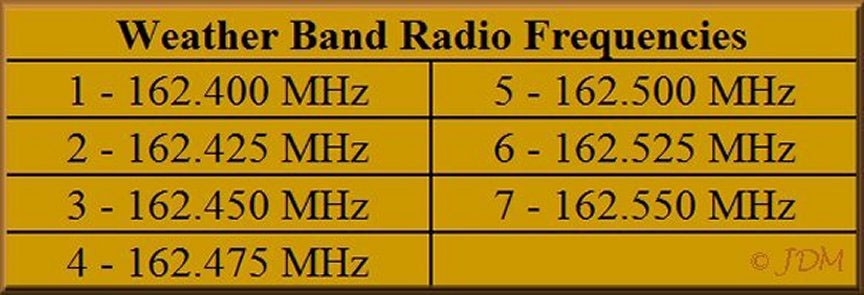
SHORTWAVE RADIO
Shortwave radio uses shortwave frequencies between the AM and FM bands, generally between 1.6 MHz - 30 MHz. It is often used for long distance communication by means of skywave or skip propagation, in which the radio waves are reflected or refracted back to Earth from the ionosphere, allowing communication around the curve of the Earth. Shortwave radio is used for broadcasting of voice and music, and long-distance communication to ships and aircraft, or to remote areas out of reach of wired communication or other radio services. Additionally, it is used for two-way international communication by amateur radio enthusiasts for hobby, educational and emergency purposes. You do not need a license to own a shortwave receiver. If something was to happen to the power grid in the U.S. a shortwave radio might allow you to pick up transmissions from other countries, which might provide you with needed information.
I have a small Grundig Traveler II Digital radio that has AM, LW (Longwave), FM, and Shortwave. For me, the Longwave is a moot point, as Longwave is not used for broadcasting in the United States and Canada. It is used in the United Kingdom and in Europe. In the U.S., if you hear stations in the Longwave band, they may simply be images of AM stations.
The Grundig traveler is a nice small little radio and even with the telescoping antenna I am often able to pick up shortwave transmissions. It has a small drop-down panel on the front which allows you to select the time zone you live in and it automatically sets the time for your area. There are other options under this panel such as memory setting, alarm function, etc. Because of its size, this is a handy radio to carry in an evacuation bag. One thing I wish it had is weather band.
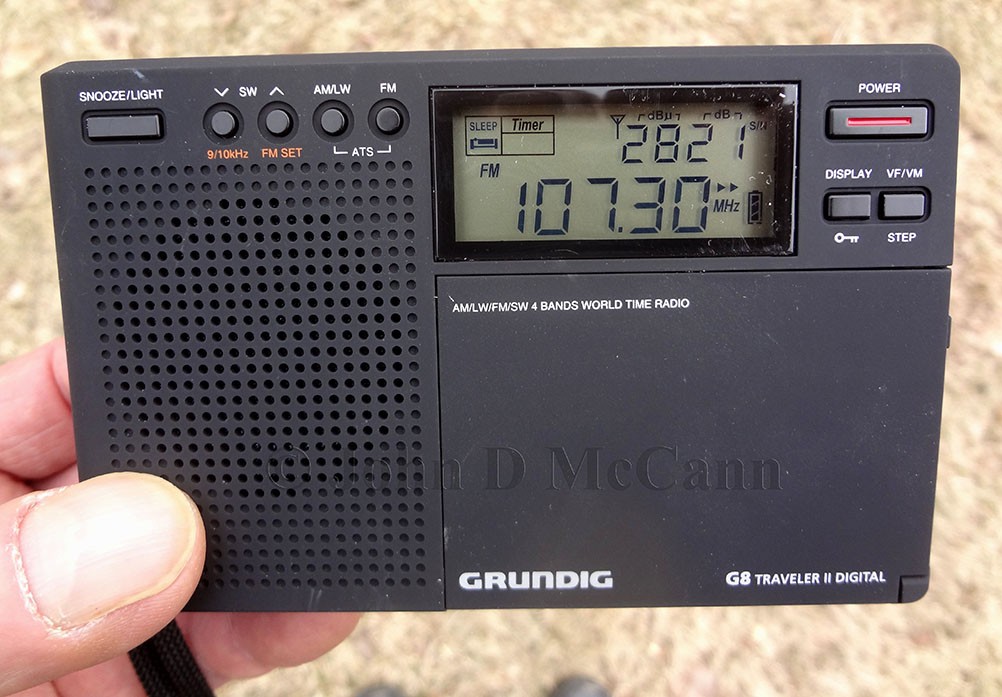 This is the small Grundig Traveler II Digital G8 radio that receives AM, FM, and Shortwave.
This is the small Grundig Traveler II Digital G8 radio that receives AM, FM, and Shortwave.
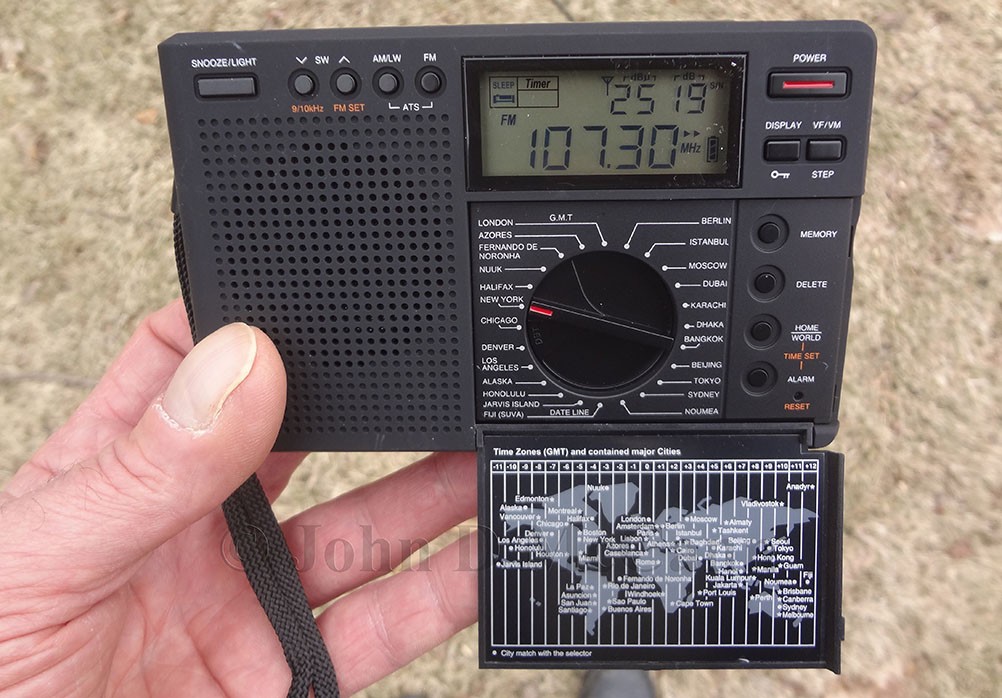 This shows the drop-down panel on the front of the Grundig Traveler II Digital G8 radio which provides
This shows the drop-down panel on the front of the Grundig Traveler II Digital G8 radio which provides
access to further tuning and setting options.
Another radio I have that receives Shortwave is the Kaito Voyager Pro. This is a great emergency radio. Larger than the Grundig Traveler II, it has many more options, especially when the power is out. It offers AM, FM, Shortwave, Longwave, and Weather Band, with the NOAA Weather Alert function. It can be powered with three AA batteries, an internal battery power pack (which can be charged using the attached solar panel or the hand crank charging system). If you have electricity, it can also be powered with the included AC adapter. It also has a 3-LED flashlight on the side, and a 5-LED reading lamp on the back of the solar panel. The front offers a temperature and humidity display and a back-lit LCD calendar and 12 hour clock, with dual alarm settings. On the back there is a built-in USB port which will charge most Smart phones and a Micro-USB input jack for auxiliary charging of the internal battery power pack. I like that the solar panel can be tilted to get the best angle of the sun. It also recharges using natural light as well as the sun. This radio offers many options for emergency situations and the sound is excellent with a built-in dynamic wide range speaker.
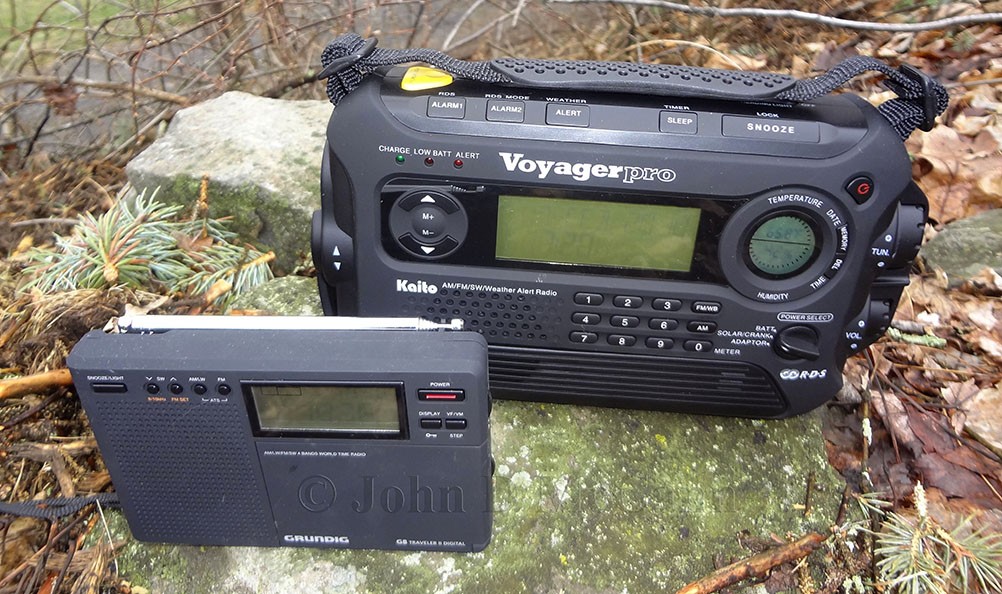 This shows a comparison in size between the Grundig Traveler II and the Kaito Voyager Pro.
This shows a comparison in size between the Grundig Traveler II and the Kaito Voyager Pro.
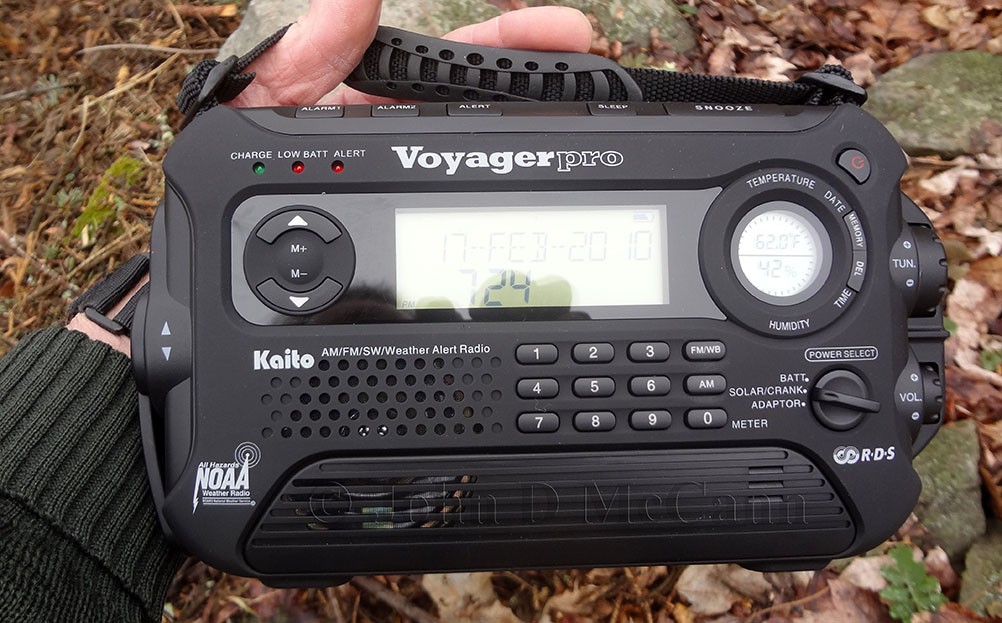 This a front view of the Kaito Voyager Pro.
This a front view of the Kaito Voyager Pro.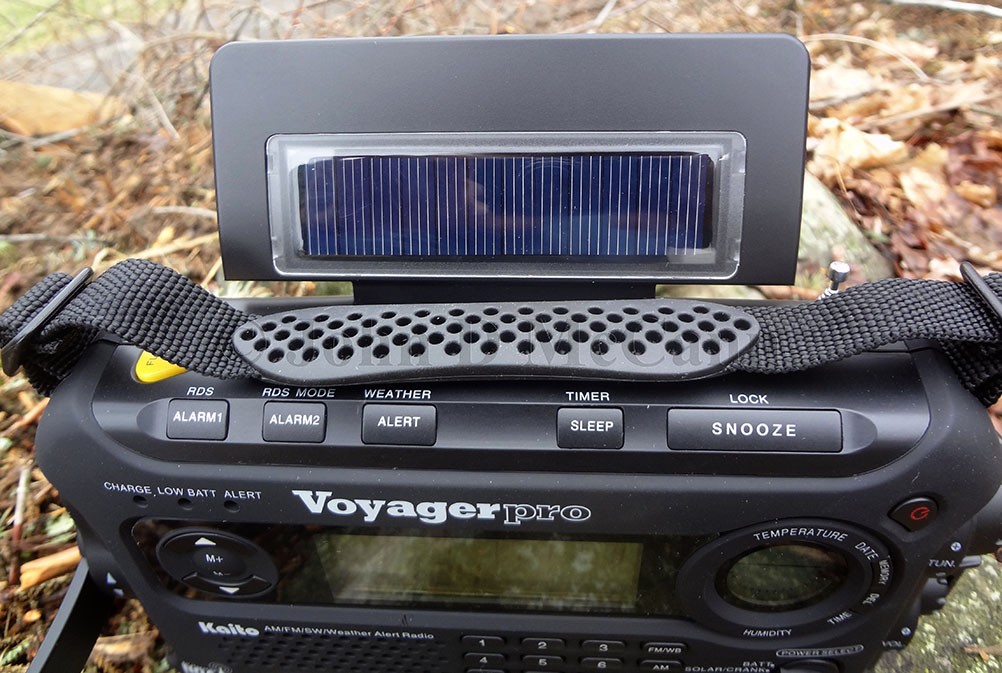 This shows the top front of the Voyager Pro with the solar panel in a raised position.
This shows the top front of the Voyager Pro with the solar panel in a raised position.
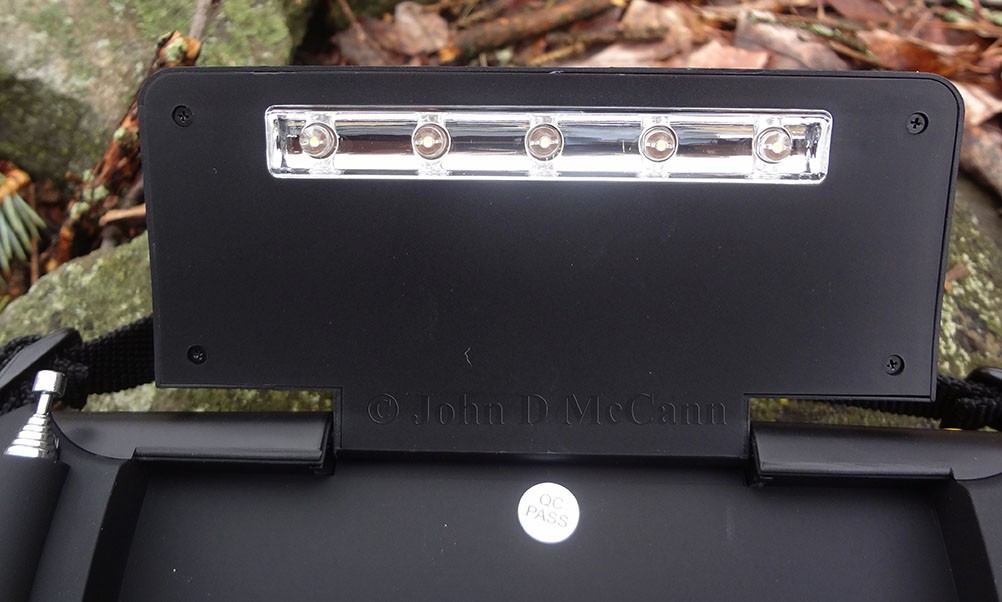 This shows the 5-LED reading light on the back of the solar panel which can be tilted to the best position for reading.
This shows the 5-LED reading light on the back of the solar panel which can be tilted to the best position for reading.
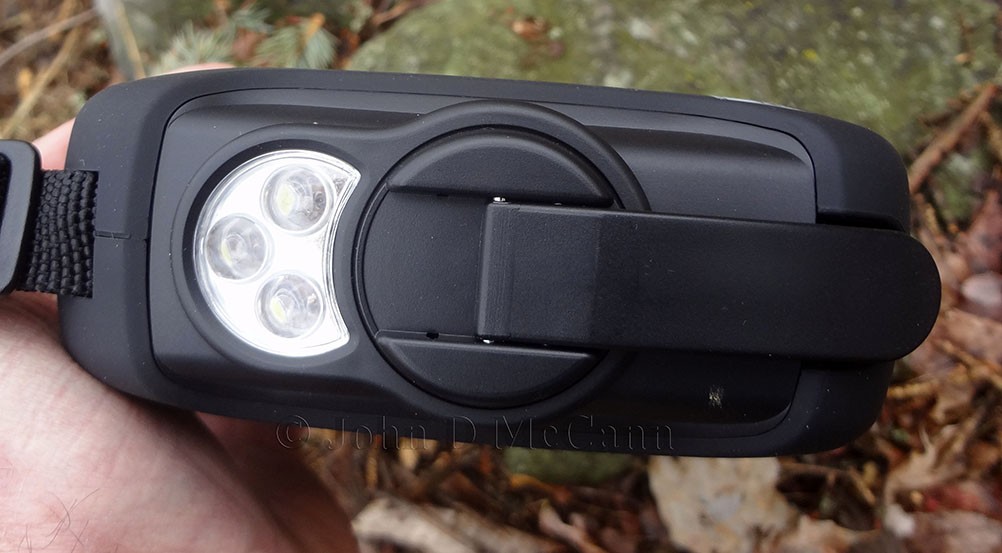 A view of the 3-LED flashlight and hand crank in the closed position.
A view of the 3-LED flashlight and hand crank in the closed position.
When using a small Shortwave radio, a wire antenna can help increase your chance of receiving a signal. I have a small handheld compact wire antenna that helps improve the performance and reception of Shortwave radios. It extends from its reel to 23 feet and can be hung vertically, or pulled up to a tree limb or other raised position with the small lanyard attachment point on one side. It has a 3.5mm plug for an external antenna jack. If your radio does not have an external jack for an antenna, this antenna includes an adapter that allows you to snap it onto a telescoping antenna. This item is very compact yet but can certainly come in handy. When you are done using it, it can be manually wound back into its case using two finger tip indents.
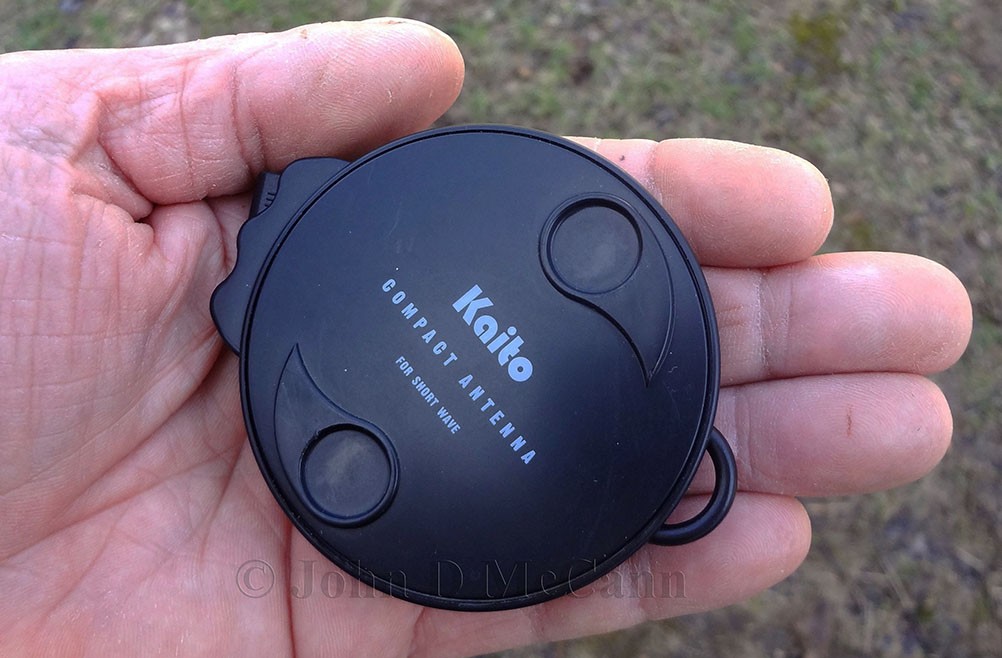 This shows the small size of the compact wire antenna discussed in the article.
This shows the small size of the compact wire antenna discussed in the article.
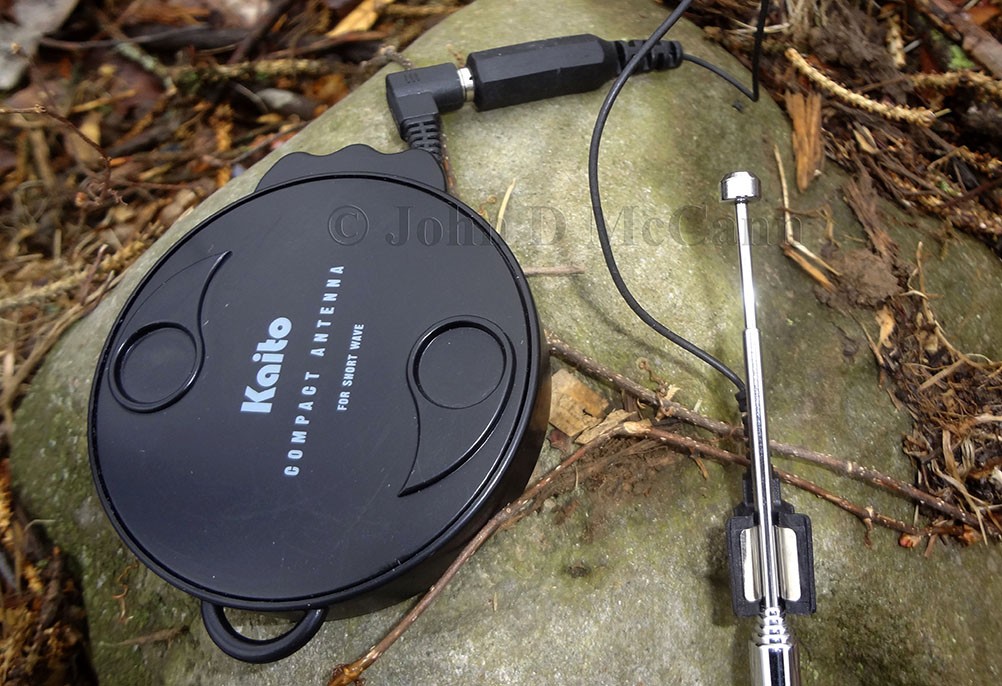 This shows the adapter for the 3.5mm plug so that you can snap it onto a telescoping antenna.
This shows the adapter for the 3.5mm plug so that you can snap it onto a telescoping antenna.
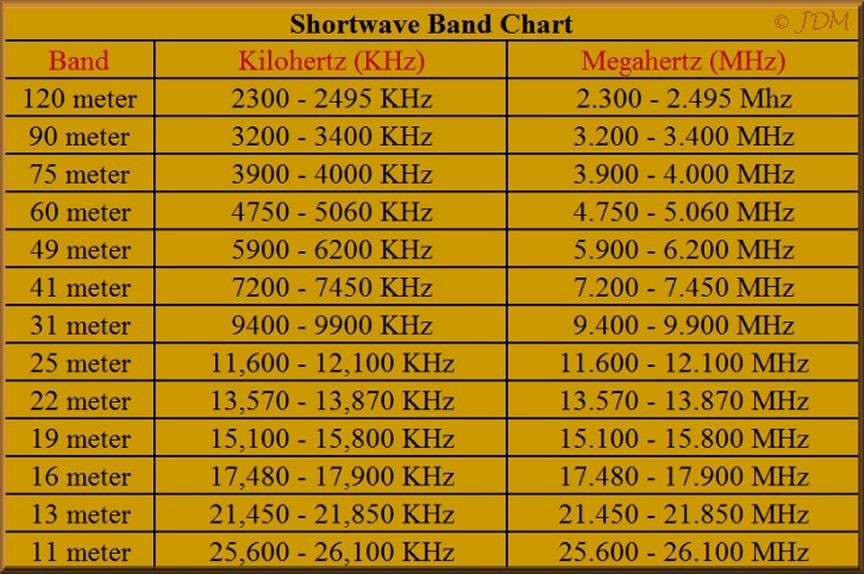 The above chart provides the Shortwave Radio Bands in both Kilohertz and Megahertz.
The above chart provides the Shortwave Radio Bands in both Kilohertz and Megahertz.
SCANNERS
Scanning radio receivers are another handy device to have during an emergency. They allow you to listen to various emergency services communications such as police, fire, and medical response. They can provide you with further information about the situation in your area.
Some of the newer scanners on the market have the "Trunk Tracker" and "Close Call" technology. The Trunk Tracker allows you to monitor two-way "Trunked" radio using Motorola trunking, EDACS (Enhanced Digital Communications System), and LTR (Logic Trunk Radio) systems. The "Close Call" feature is great for a situation where you are bugging in and want to know if someone is transmitting close to your location, possibly a recon team. This feature allows you to instantly tune to signals from nearby transmitters and listen in.
Another type of scanner is a wideband receiver. Most of these will allow you to tune or scan through most frequencies, except the cellular band. You will be able to listen to almost all communications from all of the various radios discussed in this article, and more. I have an old AOR-8000 which has a frequency range from 0.1 MHz to 1900 MHz (1.9 GHz). This provides a vast array of frequencies to obtain information from.
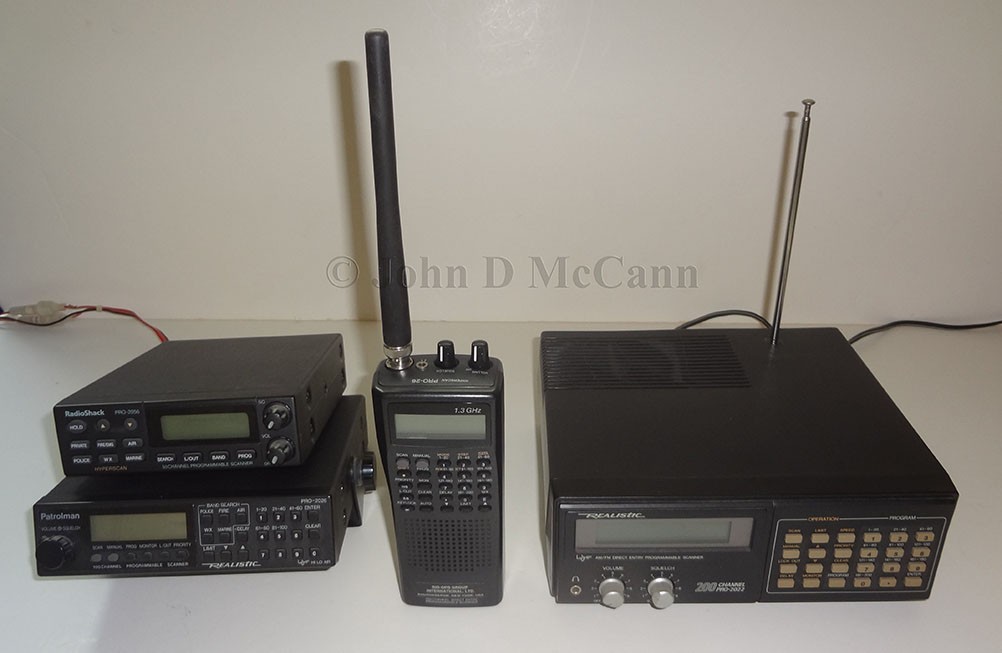 This photo shows various scanners that the author uses to collect information.
This photo shows various scanners that the author uses to collect information.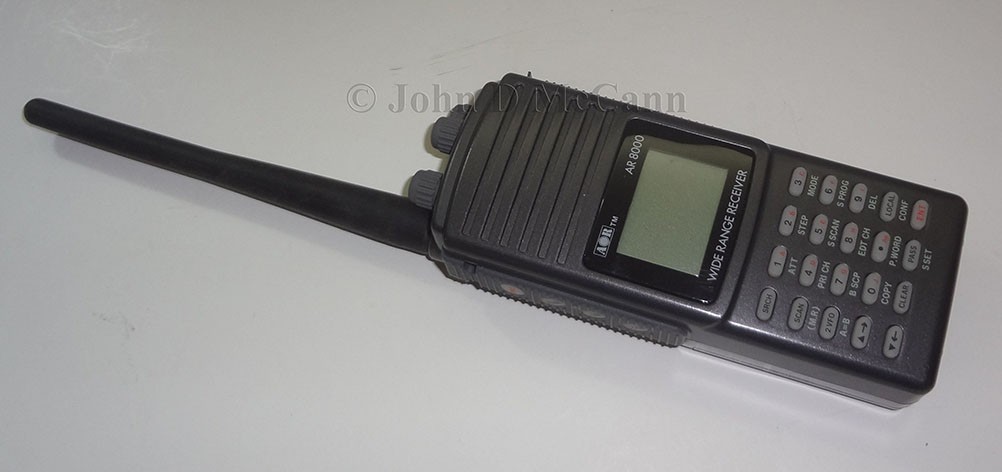 This is a wideband receiver which provides a wide range of frequencies to listen to.
This is a wideband receiver which provides a wide range of frequencies to listen to.
If you are using a base station scanner, or a mobile, invest in an external antenna and the higher you mount it, the better reception you will get. I have a large mast mount wideband Discone Antenna which provides omni-directional reception.
TWO-WAY COMMUNICATIONS
POTS, CELLULAR, AND SATELLITE PHONES
Although not always, often when there is a power failure, the POTS (Plain Old Telephone) lines will still work. However, most people today have given up the old wired analog phone and have replaced them with rechargeable wireless handsets. This type of phone sets in a charging base when not in use. Basically, when you pick it up and make a call, you are transmitting from the handset to the base. When the power goes out, these types of phones are useless. For this reason, I always keep a few of the old analog wired phones around. If the phone service is still functioning, you can plug them into the modular wall outlet and still make a call.
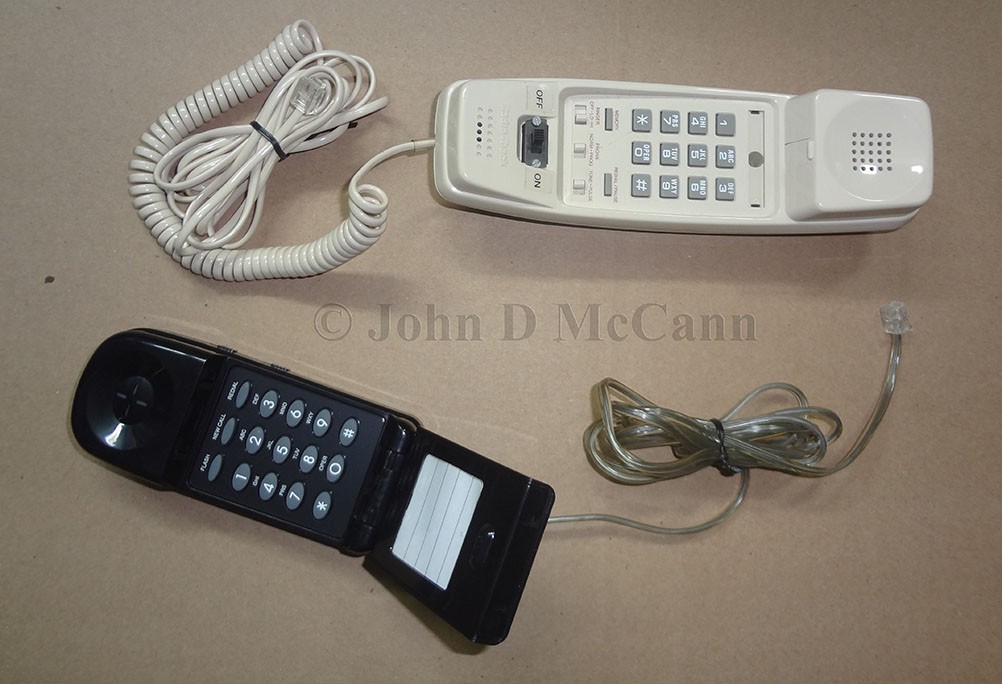 These are some old analog phones that the author keeps around to use in case of a power failure where the
These are some old analog phones that the author keeps around to use in case of a power failure where the
phone lines still work. The one on top used to set in a cradle which turned the phone on when lifted. The
author modified the old spring switch with a slide switch which reduced the size of the phone by not
needing the old cradle that the phone set in.
Another type of phone that can be used on phone lines is a Lineman's Butt Set (also known as a Test Set), which can be used anywhere you can find an active pairs of wires. The problem for carrying one for any type of evacuation kit is they are large. Many years ago I found a very small butt set called the Lil' Buttie Pro, and it is much smaller than the normal butt set. The usual Lineman's Butt Set also has a pair of leads permanently connected to the bottom. The Lil' Buttie Pro has a set of clip test leads just like a large butt set, but it is connected to the bottom using a regular modular connect. First, this allows you to remove the test leads when not in use, and Second, it allows you to use a regular modular phone cord to connect the small butt set to a regular modular outlet, just like any analog phone. I have found it very handy both at home and on the road.
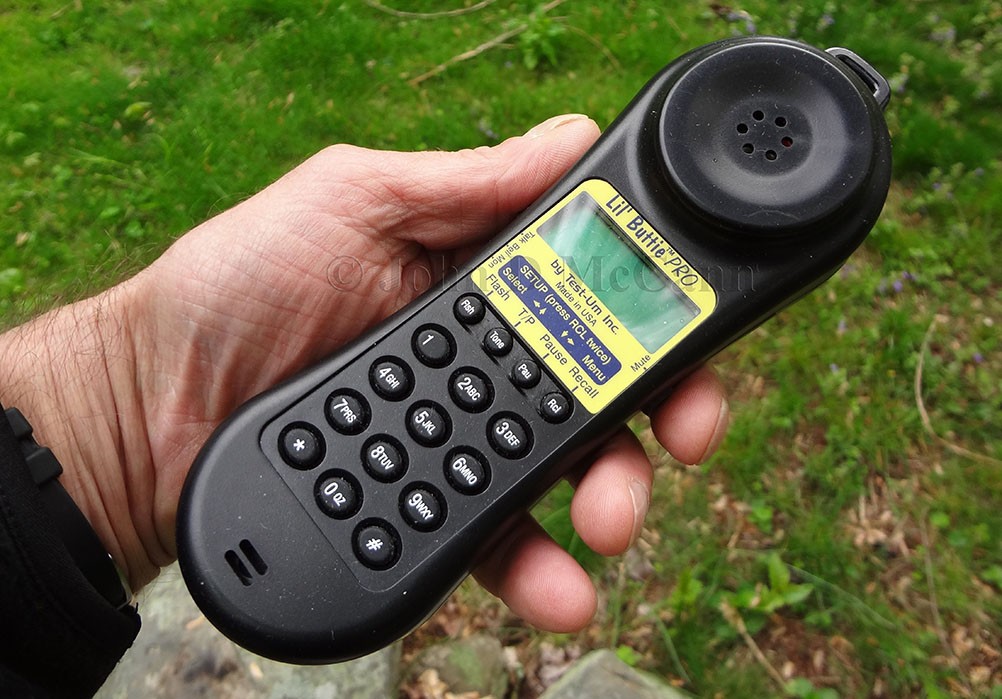 This shows the author holding the small Lil' Buttie Pro butt set to show its size.
This shows the author holding the small Lil' Buttie Pro butt set to show its size.
 This photo shows the size comparison of a normal Lineman's Butt Set on the left, and the Lil' Buttie Pro Butt
This photo shows the size comparison of a normal Lineman's Butt Set on the left, and the Lil' Buttie Pro Butt
Set on the right.
If you have a fiber optic telephone system, you may still have a viable means of communication when the power goes out. With the old POTS lines, your phone was powered with voltage from the Central Station of the phone company. With fiber optic, your system is powered at your location. I am not familiar with all types of systems, but I am familiar with the Verizon system.
With a Verizon fiber optic phone system, a ONT (Optical Network Terminal) is placed at your location. The ONT converts the incoming fiber optic light signals into copper/electric signals. These systems have a battery backup for power failures, but normally last only about eight hours. However, they can be powered by a generator, a UPS (Uninterruptible Power Supply), or by having additional batteries for the battery backup. I have various 12 Volt batteries available which can be used to power the ONT in the event a power outage lasts longer than eight hours.
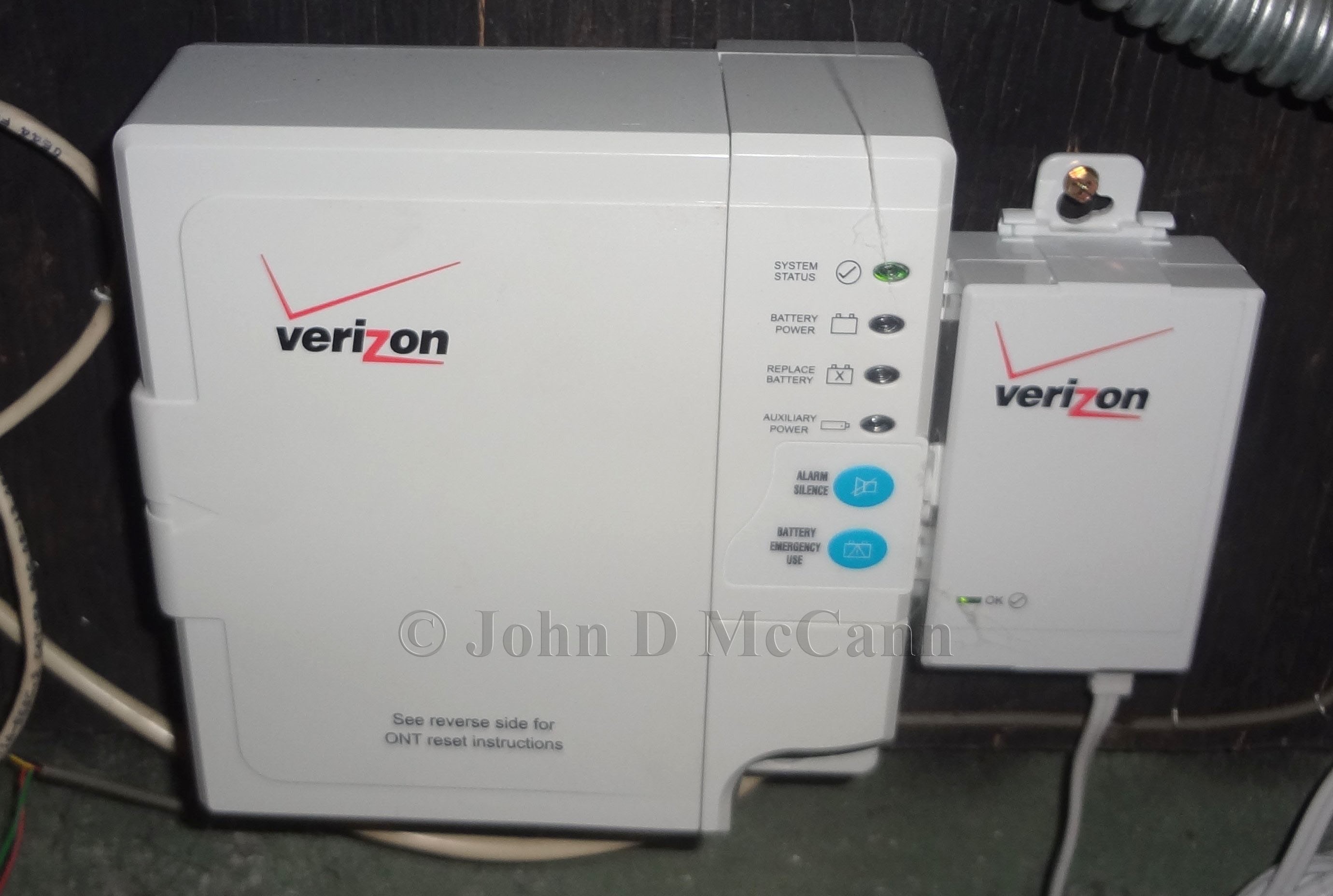 This photo shows a normal Verizon ONT (Optical Network Terminal) as discussed in the text of the article.
This photo shows a normal Verizon ONT (Optical Network Terminal) as discussed in the text of the article.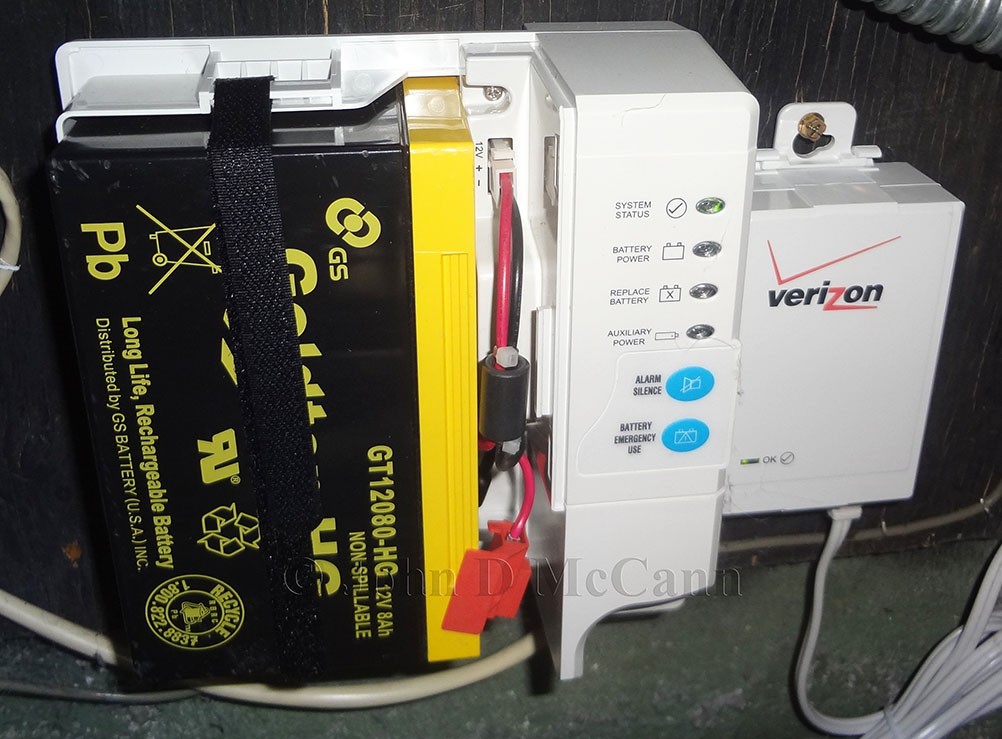 This photo shows the Verizon ONT open revealing the 12 Volt backup battery. This is where you would
This photo shows the Verizon ONT open revealing the 12 Volt backup battery. This is where you would
connect an alternate battery if this one goes dead.
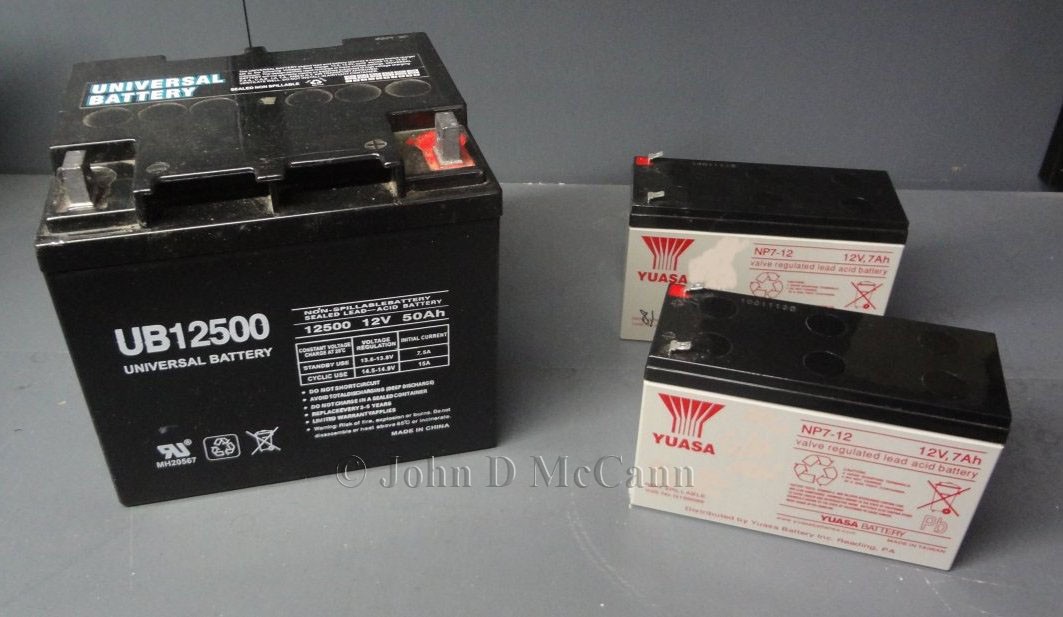 This shows some of the types of alternate 12 volt batteries that the author keeps around. They are recharged using a small solar array.
This shows some of the types of alternate 12 volt batteries that the author keeps around. They are recharged using a small solar array.
If you have a fiber optic telephone system that is not Verizon, I would highly suggest that you become familiar with the system you have so you can keep it running if the power goes out, but phone service is still available.
Cellular phone service often goes out when there is a large scale power failure. Also, when an emergency situation occurs, the cellular towers can become overloaded from too many calls. Sometimes they will work for a while, but when service is lost, or overloaded, your cell phones are nothing more than a paperweight. However, there are times when you can send a text message even when a call won't go through. This is because a text message takes up far less bandwidth than an actual call. So even when you can't get a cell call through, keep attempting to send a text message. It just might work.
Satellite phones use low-orbiting satellites to communicate. Although the price and size of satellite phones have both been reduced since they first came out, they are still relatively expensive, and this does not include monthly charges for service and or airtime, which can be very costly. They are an option for communication, but an expensive one.
CB RADIOS
What I like about CB Radios is that they can be used for both personal and business use, and do not require a license. Ham radios, which will be discussed later in this article, can only be used for personal use and require a license, if you transmit with them.
CB Radios are available in both base stations for the home, mobile units, and hand held units. I prefer mobile units even for the home because they are powered by 12 Volt which I always have available through both solar panels and a bank of batteries. Mobile units are handy when travelling as you can communicate with other drivers equipped with a CB, and can often find out what is happening on the road ahead of you.
I also like to have a handheld CB so that if a passenger needs to get out of my vehicle, they can communicate back to my mobile unit. I have a Midland 75-822 Handheld that can be powered with AA batteries or the battery case can be removed and replaced with a 12 Volt vehicle adapter. It provides a 12 Volt accessory outlet plug and an external antenna cable connection point, allowing you to use an external antenna on your vehicle like a mag-mount or stick, which increases the range of the radio. I find it a very versatile unit.
If you have a CB radio that has an external antenna (almost all will, except a handheld with an attached antenna), you should also invest in an SWR Meter. It is necessary to match the impedance between the radio and the antenna. An SWR meter is used to measure the "Standing Wave Ratio" allowing you to adjust the length of the antenna to match the optimum impedance.
I have also found that a good external speaker provides better sound quality when listening to a CB radio.
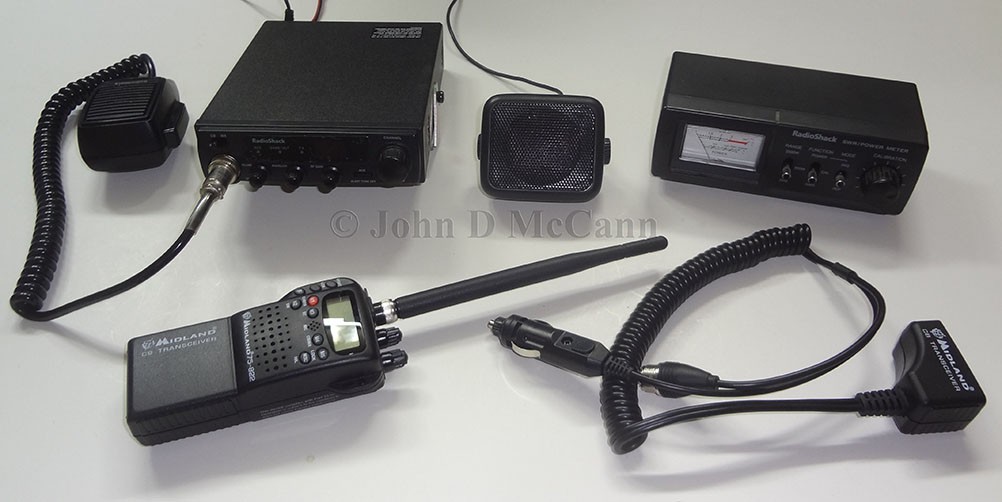 The top row in the above photo shows, from left to right, a mobile CB, an external speaker, and an SWR meter.
The top row in the above photo shows, from left to right, a mobile CB, an external speaker, and an SWR meter.
The bottom shows the author's Midland handheld CB radio with the 12 Volt and external antenna adapter
cable to the right.
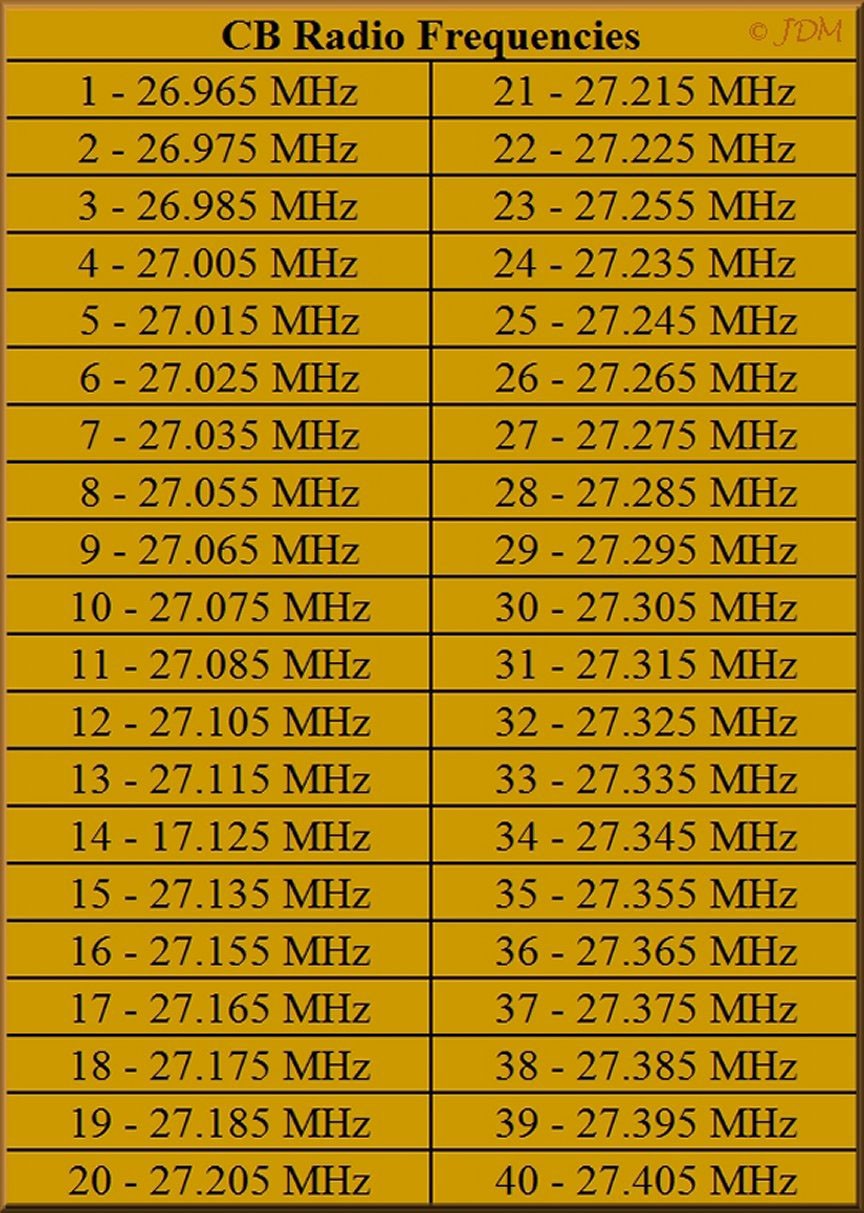
FRS, GMRS, and MURS RADIOS
A FRS (Family Radio Service) radio is a FM transceiver that uses 14 UHF (Ultra High Frequency) frequencies for short distance two-way communication. The frequencies are legal to use without a license for a hand-held radio that has a 1/2 watt maximum output of radiated power with a 2.5 KHz deviation, and a permanently attached rubber antenna. They have an effective range of less than a mile, and are limited by "line-of-sight." They are meant to provide two-way communication at a short distance and are great for use around the yard, camping, or if you stay within a short distance of other users. Because no license is required, many people choose them even though they have a short distance.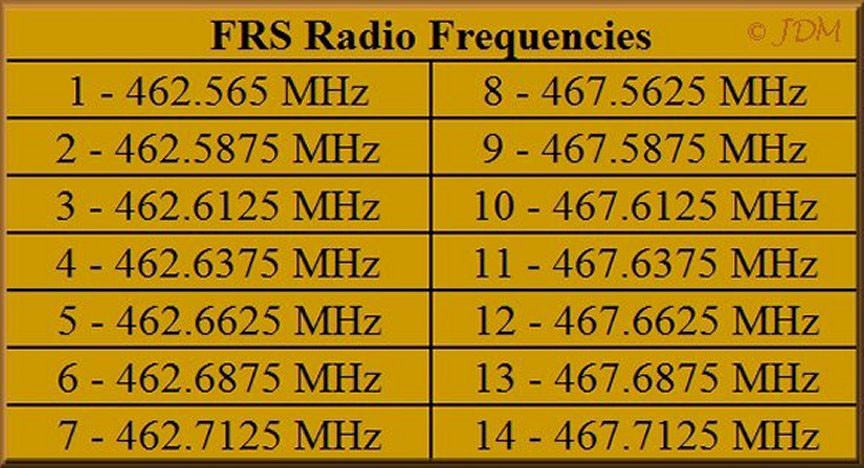
A GMRS (General Mobile Radio Service) radio is a FM transceiver that uses 23 UHF (Ultra High Frequency) frequencies, some of which are shared with FRS. For those channels not shared with FRS they can have 1-5 watt maximum radiated power with a 5 KHz deviation. For those channels shared with FRS, it is limited to the 1/2 watt maximum output radiated power. Because of the increased power of a GMRS radio, a license is required by the FCC (Federal Communications Commission). To qualify for a license you must be 18 years of age, and not a representative of a foreign government. The license costs $90.00 for a five year term and the license extends communications with the licensee's immediate family members. No test is required for the license. It should be noted that in GMRS radios that are not shared with FRS frequencies, they offer both simplex and repeater capabilities and can have detachable or external antennas.
The problem I have found with the licensing factor of GMRS is that many of these radios offer both FRS and GMRS in one radio. They are legal for anyone to purchase, and many people buy and use them. It is only in the very fine print of the instructions that you are informed that you can legally use the FRS frequencies in the radio, but before using the GMRS frequencies, you need to obtain a license. I have seen many people using FRS-GMRS portable radios and often wonder how many actually have a license.
I have several FRS/GMRS radios and my favorite at this point is the Motorola Talkabout MR350R. These radios also receive NOAA Weather Radio as well as alerts. They can operate on a rechargeable NiMH battery, which can use a desktop charger (included) or a mini USB port. They can also operate on three AA alkaline batteries. They have a lot of options that many of the smaller units lack. The only thing I don't like is the small belt clips provided that allows the radio to swivel, but if you hit the top button, it releases the radio. I didn't find it very secure, so I bought a pair of Maxpedition holsters that provide them with further protection and secure the radios well. They have heavy-duty belt clips as well.
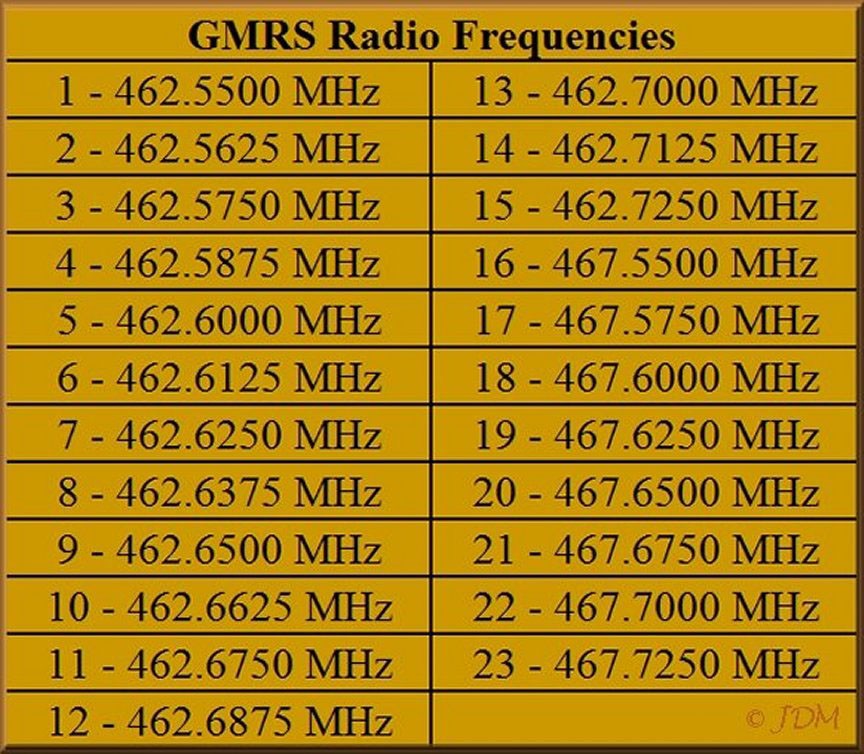
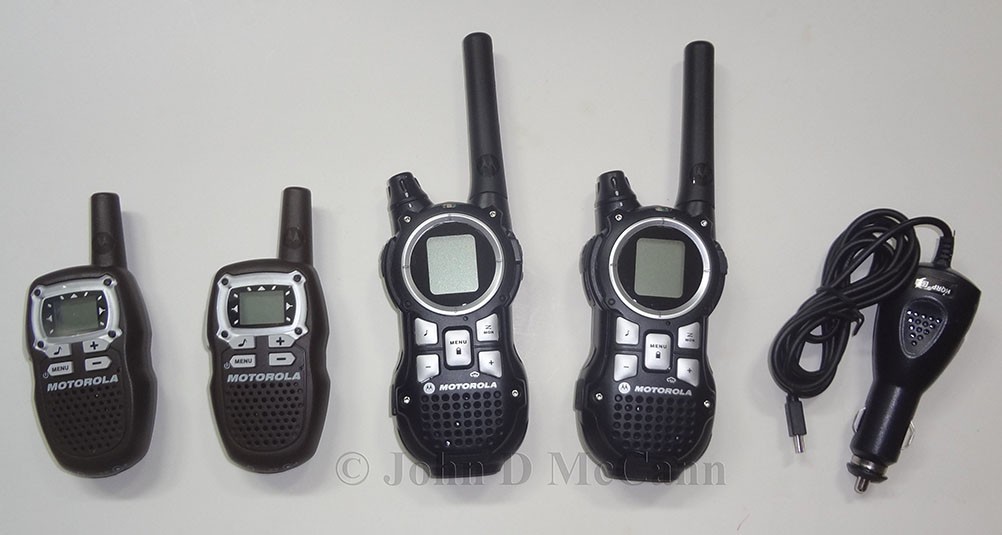 This shows two of the author's short range and two longer range FRS/GMRS radios. To the right is a 12 Volt
This shows two of the author's short range and two longer range FRS/GMRS radios. To the right is a 12 Volt
radio charging adapter which allows the radios to be recharged from a vehicle or with one of the author's
portable solar panels.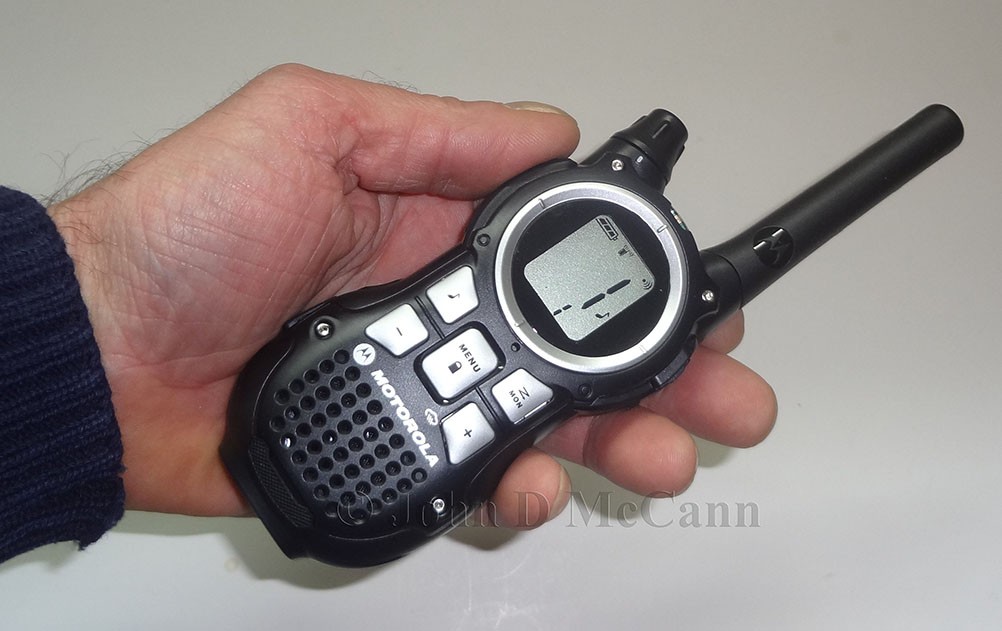 This shows the size of the larger Motorola Talkabout MR350R, FRS/GMRS radio.
This shows the size of the larger Motorola Talkabout MR350R, FRS/GMRS radio.
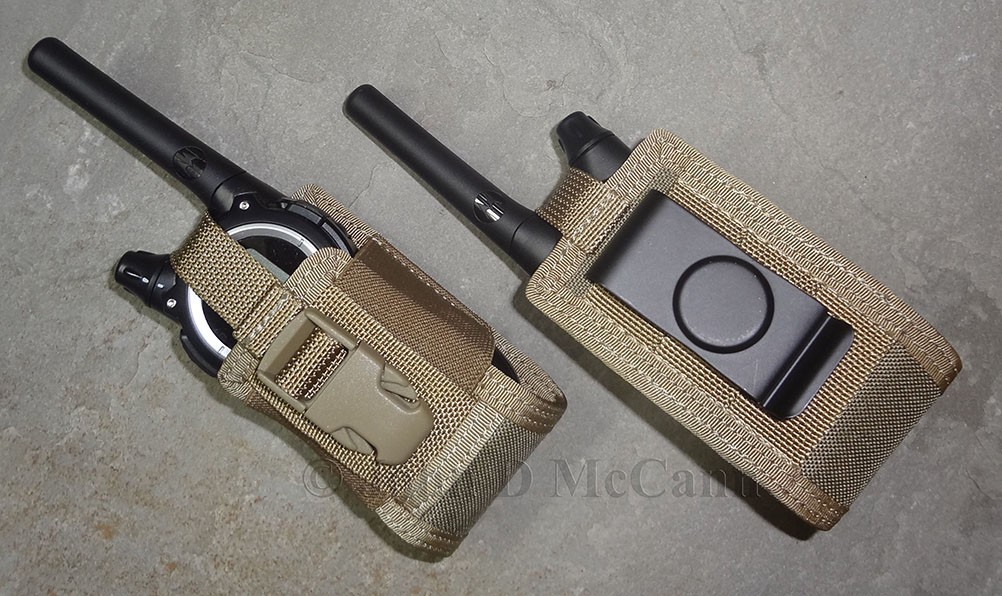 This shows the Maxpedition holsters the author uses to carry the Motorola Talkabout radios.
This shows the Maxpedition holsters the author uses to carry the Motorola Talkabout radios.
A MURS (Multi-Use Radio Service) is an often overlooked FM transceiver, but has many advantages. It uses 6 VHF (Very High Frequency) frequencies. The first three in the 151 MHz range uses FM narrow band, and the last two in the 154 MHz range uses FM wideband. There is no license required for use and they are inexpensive. They can have a 2 watt maximum output of radiated power, which is less than a GMRS, but four times the power of an FRS radio. You can also use an external antenna (up to 60 feet in height) which can greatly increase the effective range of the radio. Although I have yet to get one of these radios, it is definitely on my buy list!

AMATEUR (HAM) RADIOS
Amateur Radio is also known as Ham Radio. You do not need a license to own or listen to a ham radio. However, if you want to transmit with a ham radio, you are required to have a license in the U.S. which is issued by the FCC. The easiest license to obtain is the "Technician" class license, as it does not require that you learn Morse code. You must pass a written exam which then allows you to have up to 1500 watts of transmitting power on frequencies above 30 MHz.
There are many different Amateur bands, which are each divided into various usage depending on license type and whether it can be used for Morse code, voice, data, or other use. I will not provide a chart for these bands as they get rather complicated. However, if you are interested in getting your license, or learning the different bands and their allowed usage, you can search the internet or get one of the many books by The American Radio Relay League.
I have found that a small hand-held Amateur radio provides you with basically a wide band receiver for emergency situations, and is a great choice for an evacuation bag. Keep in mind that you need a Ham Radio license to transmit with the radio.
I have the Yaesu VX-3R/E, which is an ultra compact Dual-Band Transceiver (VHF-UHF) with a wide band coverage. If you have a license, you can transmit up to 1.5 Watts on VHF and up to 1 Watt on UHF. As a receiver it provides coverage on AM, FM, Shortwave, VHF and UHF TV bands, VHF aircraft band, and a wide range of commercial and public frequencies. It also has the NOAA weather band stations pre-programmed in a memory channel when you get it. Overall, this is a great little radio, even if you are only using it for listening.
I bought some additional options for the Yaesu which provides it with further advantages. It comes with a rechargeable lithium Ion battery, so I also got a battery case adapter that allows me to use 3-AA Alkaline batteries if I choose (I was disappointed to find that you cannot use rechargeable AA batteries). I also got a cigarette lighter adapter so it can be powered in a vehicle or other 12 volt battery.
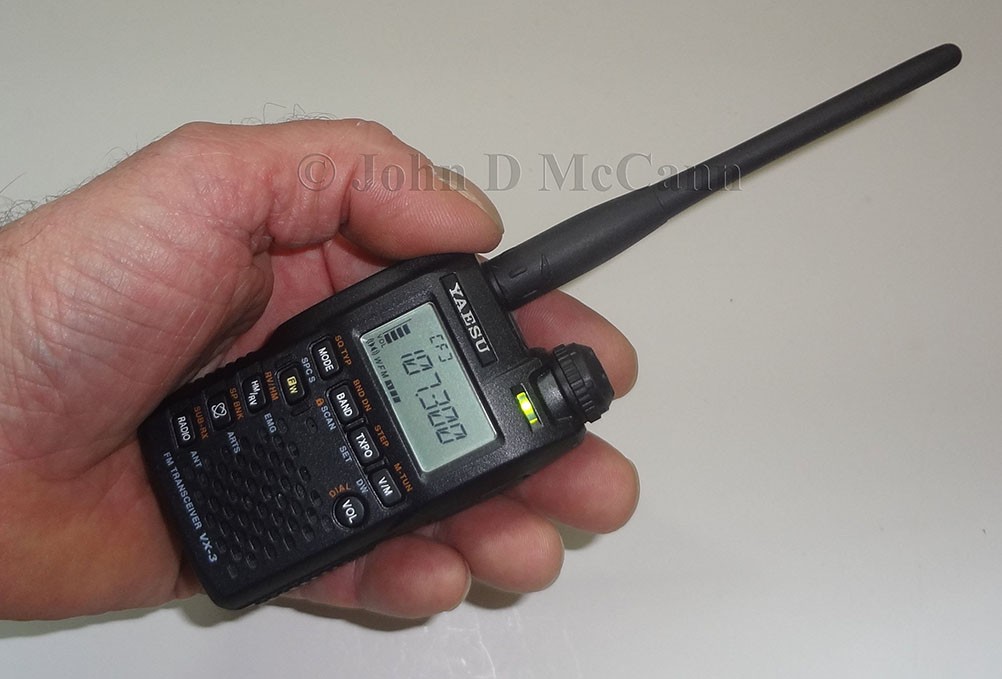 This shows the author's small Yaesu Ham Radio tuned to an FM station.
This shows the author's small Yaesu Ham Radio tuned to an FM station.
There are many different sized ham radios available with many options. I find a small hand-held handy, but a base station at your home is not a bad idea, especially if you have a license to transmit. I have a friend who likes the older tube radios, as it is believed that they might very well survive an Electromagnetic Pulse (EMP).
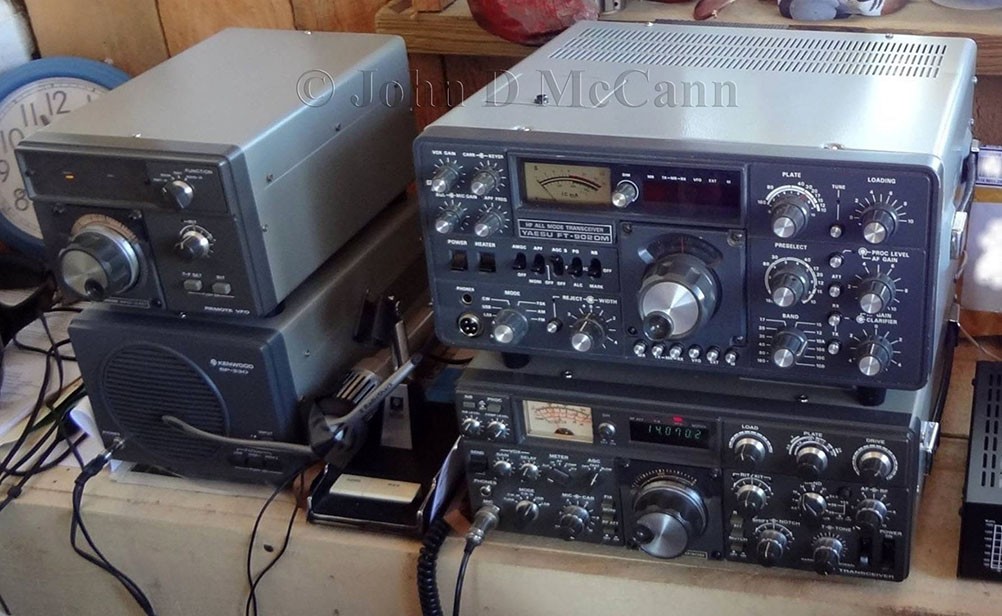 This is a Ham Radio set up using older tube technology. It is believed that tube radios might still function
This is a Ham Radio set up using older tube technology. It is believed that tube radios might still function
after an EMP (Electromagnetic Pulse).
SUMMARY
As you can see, there are many options available for you to obtain information during an emergency situation, as well as communicate with others. Although I have tried to touch on many of those options, this is just the beginning. You will need to determine your needs and wants, and take it from there.
If you are interested in keeping your electronic devices charged during an emergency, check out my article Recharging On The Go.
We hope you enjoyed this article and will help support our efforts by checking out our products. As always, Be Prepared To Survive!
Copyright © 2015 by John D. McCann


